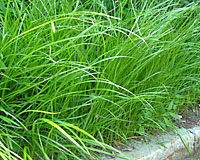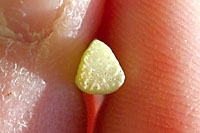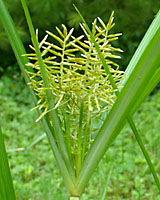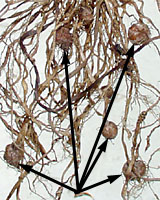Terry L. Ettinger Horticulture Consulting Services
Meeting The Needs Of Today With A Vision For The Future
Special Topics
Worst Weeds in Landscape Plantings
Yellow Nutsedge - Cyperus esculentus
 Also known as nutgrass, yellow nutsedge,
at right, is not a true grass, but rather a sedge with a three-sided stem.
These distinct stem faces are relatively easy to detect by rolling
the stem between your thumb and index fingers, below left.
Also known as nutgrass, yellow nutsedge,
at right, is not a true grass, but rather a sedge with a three-sided stem.
These distinct stem faces are relatively easy to detect by rolling
the stem between your thumb and index fingers, below left.
 Unless your
property is located next to a wet area where itís native here in
Central New York, any nutsedge growing in your landscape was likely introduced in
soil or mulch brought onto your property.
Unless your
property is located next to a wet area where itís native here in
Central New York, any nutsedge growing in your landscape was likely introduced in
soil or mulch brought onto your property.
 Nutsedge can reproduce by seed,
at right. However, its principle means of reproduction are by tubers produced in late summer at the
tips of the current seasonís roots.
Nutsedge can reproduce by seed,
at right. However, its principle means of reproduction are by tubers produced in late summer at the
tips of the current seasonís roots.
What makes this weed difficult to control is that each plant, which are killed by the first frosts of the year, can produce dozens of small tubers, below left at tips of arrows. While most of these tubers will sprout the following spring, some remain in ďstealthĒ mode (i.e., dormant) for several years, thus increasing the chances for the infestationís survival.
 The key to controlling this weed, therefore, is to kill it before
it starts forming
new tubers in July and August. This can be accomplished with a
non-selective, glyphosate-containing herbicide such as
Roundup, or simply by uprooting young plants with a
diamond hoe.
The key to controlling this weed, therefore, is to kill it before
it starts forming
new tubers in July and August. This can be accomplished with a
non-selective, glyphosate-containing herbicide such as
Roundup, or simply by uprooting young plants with a
diamond hoe.